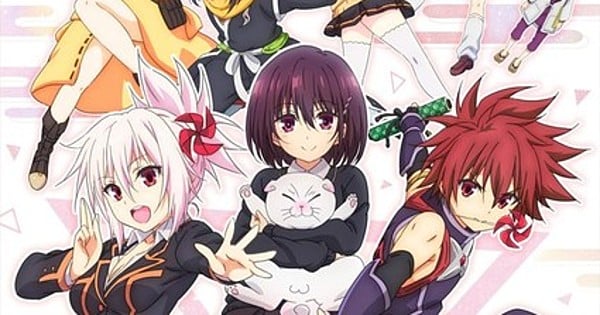Curated From www.animenewsnetwork.com Check Them Out For More Content.
Which anime of 2023 was most unjustly ignored by the masses? While my vote would probably go to fall’s Migi & Dali, a fantastic and uncomfortable comedy thriller that seemed to pass most anime fans by, I also harbor a soft spot for ecchi comedy Ayakashi Triangle, murdered by severe production woes. Initially planned to run for twelve episodes during the Winter 2023 season, it soon ran into difficulty, with the fifth and sixth episodes delayed by a month to run in mid-March. Taking the entirety of the spring season off, Ayakashi Triangle re-ran from episode one in July, with no new installments streamed until the end of August. It seems everyone forgot about it – even the Reddit episode discussion threads were populated mostly by lonely tumbleweeds.
While it’s no animated masterpiece by any stretch of the imagination, this colorful and fun adaptation of To Love-Ru artist Kentaro Yabuki‘s extremely cheeky and (mainstream shonen) boundary-pushing manga deserves to find an audience. One of the reasons I find Ayakashi Triangle so amusing is its witty and deranged approach to censorship. The uncensored print version of the manga is full of heaving bosoms, fully unleashed nipples, glistening thighs, and endless panty-shots. Already, such a high concentration of fanservice alienates a huge section of fandom, while attracting another. How to appease both sides? Strict Japanese TV broadcast rules mean that there’s no way Ayakashi Triangle could have been shown uncensored. Still, instead of cutting scenes, using ugly shadowing or intrusive “god rays,” director Noriaki Akitaya decided to have fun with it.
Nudity remains prevalent, as does the camera’s fixation on both Suzu’s and newly transformed Matsuri’s ample curves and barely-hidden underwear. To preserve “decency,” the censorship method of choice is… the floating, screaming head of perpetually-scandalized ayakashi cat Shirogane. In-story, the now mostly powerless Shirogane’s motivation for sex-swapping Matsuri was to prevent our two heroes from getting intimate, so it makes sense that the metatextual censorship means that every time a nipple appears, it’s obscured by a floating strawberry with a Shirogane face. Or buttocks hidden by a split upside-down peach spewing forth a Shirogane. Or crotch shots concealed by a chocolate donut with a Shirogane in the center.
No two instances of this comedic censorship are ever quite the same, and they greatly enhance the already goofy humor. I imagine the uncensored Japanese Blu-rays are probably much less fun. If you want bare nipples, you’re probably best to watch straight-up hentai instead – Ayakashi Triangle isn’t going to do it for you.
Matsuri is a fairly typical shonen protagonist – strong, energetic, hard-working, and protective of his female love interest, but not in touch with his feelings enough to recognize his attraction to her. At the end of the first episode, when he’s transformed into a pink-haired bombshell, we realize Ayakashi Triangle isn’t quite like other cookie-cutter shonen action shows. To progress, Matsuri doesn’t only need to train hard, he needs to get in touch with his “feminine side”. Although his fish-out-of-water status is often played for laughs, Matsuri soon realizes that indulging in femininity has advantages. He makes other friends for the first time in his life, and he can be much closer to Suzu to protect her.
Suzu herself is conflicted – she enjoys having Matsuri as an integral part of her female friend group, plus the fact the object of her love is now a girl means they can interact much more closely, and often. However, Suzu feels responsible for Matsuri losing his male body and vocally expresses her desire to reverse his transformation. Although it’s pretty clear that she’s still attracted to this female version of Matsuri, that’s not delved deeply during the early segment of the manga that is adapted. There are hints that Suzu’s sexuality is flexible when it comes to Matsuri.
The supporting casts are enjoyable – from permanently scowling shark-like exorcist ninja rival Soga Ninokuru (who finds Matsuri’s transformation adorably troubling), to artisan Reo Korogi who’s like a hornier version of my favorite My Hero Academia character, the engineer Mei Hatsume. Alien-obsessed school friend Lu is funny with her bizarre misinterpretations of events. At the same time, the energetic Yayo’s weird sexual harassment fetish gets old quickly, thankfully, just as the show stops featuring it.
Aesthetically, it’s pretty average – the character designs are attractive, though often off-model in wider shots. Matsuri’s ninja outfit and pinwheel windmill motif are cool. The animation is generally functional, though on occasion, during action scenes, or even just random character shots, quick bursts of high-frame, super-detailed, and smooth, fluid motion look great. The ayakashi are often extremely cute, almost like something from a Ghibli movie (though far more static, unfortunately.) More grotesque enemies look like generic misshapen monsters from a cut-price Jujutsu Kaisen but do the job.
For a supposedly dumb ecchi show, there’s a surprising level of emotional intelligence, especially towards its climax in episodes ten and eleven, when every main character must set aside their differences and work together to fight a truly despicable foe. The fallout from this helps tie themes developed from the early episodes together very nicely in the final episode, which acts as a fitting, chilled coda. I think it’s improbable we’ll get any more Ayakashi Triangle animated. Still, if you’re willing to give this deeply silly, unceasingly horny action comedy a shot, then once you’re done with the short but sweet anime, the recently-completed manga will be there for you.

